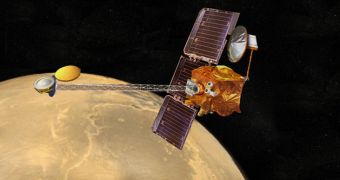In September 2008, NASA lost contact with its Phoenix Mars Lander robot, a scientific platform deployed at high latitudes on Mars. Its goal was to search for water-ice deposits, and also to collect new data about the weather patterns and phenomena present in its area. Two months after its originally-planned, three-month-long stay, the machine was finally subdued by the cold temperatures and lack of sunlight in the region. But experts did not abandon hope that the machine could be reawaken, and they conducted three “listening” campaigns using the NASA Mars Odyssey orbiter.
The spacecraft, in orbit around Mars since 2001, was taken away from its regular scientific duties three times this year, each time for about a week. During these campaigns, the orbiter searched for potential radio signals that Phoenix may have produced. The lander has a built-in Lazarus Mode, which is meant to make the craft send out radio signals, to be picked up by either Odyssey, the Mars Reconnaissance Orbiter (MRO), or the European Space Agency's (ESA) Mars Express. The orbiters would then relay the data to mission control, at the Pasadena, California-based NASA Jet Propulsion Laboratory (JPL).
The first campaign was conducted in January, with another one following the next month. No results were obtained during these two studies, as Phoenix remained silent. The third and final campaign took place last week, when Odyssey flew about 60 orbits over the lander's location, before resuming its usual duties. Unfortunately, this flight too ended in failure. Experts at JPL warned from the get-go that the efforts may be in vain, given the extremely rough nature of the conditions that Phoenix had to endure near the Martian north pole. The third listening effort was conducted between April 5 and April 9, when the Sun was above the horizon at the target location at all times.
“In the unlikely event that Phoenix had survived the harsh Martian arctic winter and been able to achieve a power-positive state with the return of continuous sunshine, there is a very high likelihood that one or more of these 60 overflights would have overlapped with a transmission attempt by the lander,” explained JPL Mars Exploration Program chief telecommunications engineer, Chad Edwards. “This was the last of our three planned Phoenix search campaigns. The Mars program will evaluate the results in hand to assess whether further action is warranted,” he concluded.

 14 DAY TRIAL //
14 DAY TRIAL //